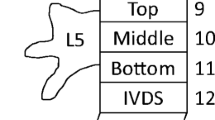Summary
The object of this retrospective study was to determine the sites of abdominal aortic bifurcation and inferior vena cava confluence in relation to age and sex. The study group comprised 180 subjects (90 males and 90 females) divided into 9 groups by age (in decades). The positions of the aortic bifurcation and the inferior vena cava confluence were evaluated by CT, and linear regression models were fitted to the data. The positions of the aortic bifurcation and venous confluence showed a highly significant downward shift with increasing age (p=0.0001). The shift was more pronounced in women. The mean site of the aortic bifurcation for the whole group was at lower L4 (range, upper L3 to upper S1); in males, it was at upper L4 (range, upper L3 to upper L5), and in females at lower L4 (range, upper L3 to upper S1). The mean site of the venous confluence for the whole group was at disc L4–L5 (range, lower L3 to upper S1); in males, it was at disc L4–L5 (range, upper L4 to disc L5–S1), and in females at disc L4–L5 (range, lower L3 to upper S1). Thus, the aorta and the inferior vena cava can extend as low as the level of S1. These data are of relevance in laparoscopic procedures, especially in laparoscopic lumbar discectomy.
Résumé
Le but de cette étude rétrospective était de déterminer la topographie de la bifurcation de l'aorte abdominale et de la confluence cave caudale en fonction de l'âge et du sexe. Le groupe étudié comprenait 180 sujets (90 de sexe masculin et 90 de sexe féminin) divisés en 9 groupes d'âge (9 décennies). Les positions de la bifurcation aortique et de la confluence veineuse cave caudale ont été évaluées par tomodensitométrie, et des modèles de régression linéaire ont été appliqués aux données recueillies. Un déplacement caudal des positions de la bifurcation aortique et de la confluence cave caudale était hautement corrélé à l'âge (p=0.0001). Le déplacement était plus prononcé chez les femmes. La position moyenne de la bifurcation aortique pour le groupe entier était la partie caudale de L4 (extrémités : partie supérieure de L3, partie supérieure de S1) ; chez les sujets de sexe masculin, elle se situait à la partie supérieure de L4 (extrémités : partie supérieure de L3, partie supérieure de L5), et dans le sexe féminin à la partie caudale de L4 (extrémités : partie supérieure de L3, partie supérieure de S1). La situation moyenne de la confluence cave caudale pour le groupe entier était au niveau du disque L4–L5 (extrémités : partie caudale de L3, partie craniale de S1) ; dans le sexe masculin elle se situait en regard du disque L4–L5 (extrémités : partie craniale de L4, disque L5–S1) et dans le sexe féminin au niveau du disque L4–L5 (extrémités : partie caudale de L3, partie craniale de S1). Ainsi, l'aorte et la veine cave caudale peuvent s'étendre aussi bas qu'au niveau de S1. Ces données trouvent leur application dans les procédures laparoscopiques, en particulier dans la discectomie lombaire.
Similar content being viewed by others
References
Adachi B (1928) Das Arteriensystem der Japaner. Anatomie der Japaner. Kenkyusha Tokyo, pp 11–13
Adachi B (1940) Das Venensystem der Japaner. Anatomie der Japaner. Kenkyusha Tokyo, pp 200–203
Bierman EL (1984) Ageing and atherosclerosis. Stout RW, Arterial disease in the elderly. Churchill Livingstone, New York, pp 17–29
Caird FI, Dall JLC, Williams BO (1985) The cardiovascular system. In: Brocklehurst JC (ed) Textbook of geriatric medicine and gerontology. Churchill Livingstone, London
Cloyd DW, Obenchain TG, Sarrin M (1995) Transperitoneal laparoscopic approach to lumbar discectomy. Surg Laparosc Endosc 5: 85–89
Davies PV (1967) Gray's Anatomy, 34th edn. Longmans, London, pp 839–917
Dixon AK, Lawrence JP, Mitchell JRA (1984) Age-related changes in abdominal aorta shown by computed tomography. Clin Radiol 35: 33–37
Munro I (1985) The ageing aorta (Editorial) Lancet 2: 1402–1043
Greer BE, Koh WJ, Figge DC, Russel AH, Cain JM, Tamimi HK (1990) Gynecologic radiotherapy fields defined by intraoperative measurements. Gynecol Oncol 38: 421–424
Horejs D, Gilbert PM, Burstein S, Vogelzang RL (1988) Normal aortoiliac diameters by CT. J Comput Assist Tomogr 12: 602–603
Lerona PT, Tewfik HH (1975) Bifurcation level of the aorta. landmark for pelvic irradiation. Radiology 115: 735
Lie JT (1980) The structure of the normal vascular system and its reactive changes. In: Juergens JL, Fairbairn JF, Spittel JA (eds) Peripheral vascular disease. WB Saunders, Philadelphia, pp 51–81
Matthews HH, Evans MT, Molligan HJ, Long BH (1995) Laparoscopic discectomy with anterior lumbar interbody fusion. Spine 20: 1797–1802
Mohiaddin RH, Schoser K, Amunama M, Burman ED, Longmore DB (1990) MR imaging of age-related dimensional changes of thoracic aorta. J Comput Assist Tomogr 14: 748–752
Pearce WH, Slaughter MS, Le Maire S, Salyapongse AN, Feinglass J, McCarthy WJ, Yao JST (1993) Aortic diameter as a function of age, gender and body surface area. Surgery 114: 691–697
Suter F (1897) Über das Verhalten des Aortenumfanges unter physiologischen und pathologischen Bedingungen. Arch Exp Pathol Pharmakol 39: 289–332
Voboril R [1993] The position of the aortic bifurcation. Sb Ved Pr. Lek Fak. Karlovy Univerzity Hradci Kralove Suppl 36: 87–104
Author information
Authors and Affiliations
Rights and permissions
About this article
Cite this article
Kornreich, L., Hadar, H., Sulkes, J. et al. Effect of normal ageing on the sites of aortic bifurcation and inferior vena cava confluence: a CT study. Surg Radiol Anat 20, 63–68 (1998). https://doi.org/10.1007/BF01628118
Received:
Accepted:
Issue Date:
DOI: https://doi.org/10.1007/BF01628118




